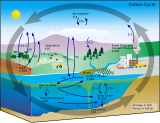
Back دورة الكربون دائمة التجمد Arabic Ciclo del carbono del permafrost Spanish چرخه کربن پایایخبندان Persian Cycle de carbone du pergélisol French

| Part of a series on the |
| Carbon cycle |
|---|
 |
The permafrost carbon cycle or Arctic carbon cycle is a sub-cycle of the larger global carbon cycle. Permafrost is defined as subsurface material that remains below 0o C (32o F) for at least two consecutive years. Because permafrost soils remain frozen for long periods of time, they store large amounts of carbon and other nutrients within their frozen framework during that time. Permafrost represents a large carbon reservoir, one which was often neglected in the initial research determining global terrestrial carbon reservoirs. Since the start of the 2000s, however, far more attention has been paid to the subject,[2] with an enormous growth both in general attention and in the scientific research output.[1]
The permafrost carbon cycle deals with the transfer of carbon from permafrost soils to terrestrial vegetation and microbes, to the atmosphere, back to vegetation, and, finally, back to permafrost soils through burial and sedimentation due to cryogenic processes. Some of this carbon is transferred to the ocean and other portions of the globe through the global carbon cycle. The cycle includes the exchange of carbon dioxide and methane between terrestrial components and the atmosphere, as well as the transfer of carbon between land and water as methane, dissolved organic carbon, dissolved inorganic carbon, particulate inorganic carbon, and particulate organic carbon.[3]
- ^ a b Cite error: The named reference
Schuur2022was invoked but never defined (see the help page). - ^ Zimov SA, Schuur EA, Chapin FS (June 2006). "Climate change. Permafrost and the global carbon budget". Science. 312 (5780): 1612–3. doi:10.1126/science.1128908. PMID 16778046. S2CID 129667039.
- ^ McGuire, A.D., Anderson, L.G., Christensen, T.R., Dallimore, S., Guo, L., Hayes, D.J., Heimann, M., Lorenson, T.D., Macdonald, R.W., and Roulet, N. (2009). "Sensitivity of the carbon cycle in the Arctic to climate change". Ecological Monographs. 79 (4): 523–555. Bibcode:2009EcoM...79..523M. doi:10.1890/08-2025.1. hdl:11858/00-001M-0000-000E-D87B-C. S2CID 1779296.
{{cite journal}}: CS1 maint: multiple names: authors list (link)